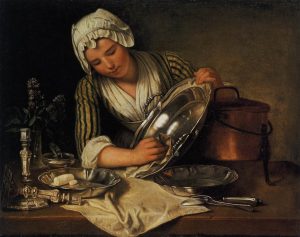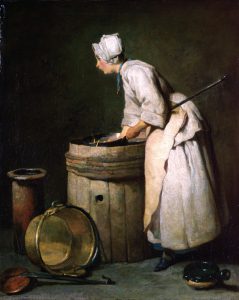 Falling down the research rabbit hole is far easier than one might expect when writing historical fiction. There are so many little things that we know about modern life that were very different in Jane Austen’s day. All of those require research in some form or another. Take for example house cleaning.
Falling down the research rabbit hole is far easier than one might expect when writing historical fiction. There are so many little things that we know about modern life that were very different in Jane Austen’s day. All of those require research in some form or another. Take for example house cleaning.
While my husband definitely didn’t marry me for my housekeeping skills, I am pretty certain about the basics of the process. The carpets need cleaning; I grab the vacuum cleaner, and occasionally the bottle of carpet stain remover. I read the directions on said bottle and go to town. The broom and mop are applied to the hard floors, usually with the addition of a specialty floor cleaning product, unless I’m really energetic and make my own with the gallon of vinegar under the sink. General purpose cleaning gets a spray of vinegar and dish detergent mixed with water. I could go on, but you get the picture.
 Trouble is, that when you start going back a couple of hundred years, you lose many of those products and options. Certainly the vacuum is out of the question. Specialty cleaning products are off the table, too. Vinegar is still around, which is quite a relief I’ll tell you, but even soap had to be home made for the most part. What is one to do when one’s main character–Lydia in this case–is forced to clean house like a maid, in a girl’s school specially set up for young gentlewomen who have allowed themselves to be compromised.
Trouble is, that when you start going back a couple of hundred years, you lose many of those products and options. Certainly the vacuum is out of the question. Specialty cleaning products are off the table, too. Vinegar is still around, which is quite a relief I’ll tell you, but even soap had to be home made for the most part. What is one to do when one’s main character–Lydia in this case–is forced to clean house like a maid, in a girl’s school specially set up for young gentlewomen who have allowed themselves to be compromised.
Hit the research books of course. Cookbooks and housekeeping manuals offer a great deal of insight into the nuts and bolts of house cleaning during the early 1800’s. One of the things that struck me immediately upon seeing how they cleaned was the amount of time and energy spent dealing with dust. Between the vacuum cleaner and the dust grabbing air filters on the AC, we have dust, but isn’t not (usually) a major concern. A swipe with a dust cloth and we’re pretty well done with it. At the turn of the nineteenth century though, the fight against dust was rather all consuming.
 The problem was rather two fold. First, heat and light came from burning things in the home. That creates soot, effectively dust. When coal was burned for heat, that created another source of dust. In industrial areas and cities, large quantities of burning coal polluted the air, with–you guessed it–coal dust and soot. So, essentially the stuff was everywhere and in everything.
The problem was rather two fold. First, heat and light came from burning things in the home. That creates soot, effectively dust. When coal was burned for heat, that created another source of dust. In industrial areas and cities, large quantities of burning coal polluted the air, with–you guessed it–coal dust and soot. So, essentially the stuff was everywhere and in everything.
To clean a room like a parlor with both hard floor and carpet, the process could get pretty complex. All the small, moveable furniture would be moved to the middle of the room. the hearth-rug would be rolled up and taken outside to be beaten. Then, in order to minimize the amount of soiling kicked up dust might cause, curtains were pinned up and cloths were put over the upholstered furniture. It would never have occured to me that there would be enough dust about to soil the furnishings in the process of cleaning.
After that, the floors would be sprinkled with wet, used tea leaves. The leaves would help trap the dust when the floor was swept, so that it could be swept up into dust shovels and removed from the house instead just tossed into the air to settle back onto the room. Afterwards, every article in the room would them be wiped with a soft cloth, duster, or dusting brush before being set into its proper place.
And this was to be done EVERY DAY!
I don’t really want to fess up how often such things get done around my home. But we’ll just say it is NOT every day. Yikes.

carpet stand
Three to four times a year, a more thorough cleaning was done. Among other things, this mean taking up the carpets which had been nailed down. Naturally this required everything in the room to be moved and the curtains to be taken down or wrapped up in cloths to keep them clean. Just think for a moment how much dust and dirt taking up the carpets would have kicked up. I’m sneezing just thinking about it.

carpet beaters
Once removed from a room, what did one do with a carpet? To start with, it was hung up over a pole, tree branch, or heavy duty line and beaten. Using a strong smooth stick or a carpet beater, the carpet was beaten twice, once on the wrong side and once on the right side until no more dust and dirt came out of it. Then it was wiped down with a clean, damp flannel cloth and left to dry.
But wait, there’s more. If the carpet had stains–and let’s be realistic, what are the chances it didn’t?–then additional measures had to be taken. Potatoes were grated into water and the liquid was sponged over faded or grease stained parts of the carpet. Supposedly this removed the grease spots and brightened the colors. To remove heavier stains, the carpet would be place on grass or a clean floor, brushed thoroughly, then scoured with a mix of gall (the contents of a bull’s gallbladder) and soapy water and dried with clean linen, then left to dry.
I don’t know about you, but all this makes me look at my cleaning closet just a little differently.
In case you’re wondering what all this research looked like in the final produce, you can find in The Trouble to Check Her.

18 comments
Skip to comment form
This makes me really appreciate my vacuum cleaner and Swiffer!
Author
Sometimes we really take that stuff for granted, don’t we?
My goodness, that is a lot to do. Those poor servants. In the 2008 movie of Sense and Sensibility, we had a scene where Elinor looked out the window and saw the servants carrying a large rug. She followed them outside where they had draped it over a large limb and were beating out the dust. She was concerned because they had just cleaned it a short time earlier. Fanny had ignored that point and requested the servants clean it again in anticipation of her brother’s visit. Thanks for this informative post. It makes me appreciate my vacuum and cleaning supplies.
Author
I recall the scene you’re thinking of. I don’t think it’s in the book, but it does effectively establish the character of Fanny, doesn’t it? I can only imagine how much work went into beating a rug!
Wow! No wonder households like Pemberley would have had an army of servants/staff! They needed them to get all this done. Exhausted just reading about it!
Author
I know, really? Makes me feel guilty for complaining about my modern version of housework.
I have the carpet beater, pictured towards the upper left (looks like an elongated heart), hanging on my wall collecting dust! I live in my grandparents old farmhouse and we found it in the basement clutter. Glad I don’t have to use it to clean the house.
Author
They are pretty to look at, aren’t they? But I sure wouldn’t want to use one!
I have a couple carpet beaters. In the US, they were used well into the 20th century. I know my grandmas had them.
I remember seeing a B movie from the early 60s which was set in London, and the mother used a carpet beater. They were a working class family.
Author
I’m not sure how you’d clean a carpet if you didn’t have a vacuum cleaner without using a beater. I actually have a neighbor across the street who beats her entry rugs in the front yard several times a week.
We live on a dirt road, and often air-ambulance helicopters land in the meadow outside our fence and really stir up the dust! When we hear the helicopter coming in low, we race to the windows to close them before the dust literally flies! I should dust much more than I do. We have carpets in this house, but our former home, now over 100 years old, had hardwood floors, and with four small children in the house plus a dog, I had to dust-mop daily. I had my great-grandmother’s cloth dust-mop on a metal pole, and the mop part could be removed and washed; it was a very clever contraption that I have kept despite only having tile in the bathrooms in this house. (Even our kitchen has indoor-outdoor carpet. Long, boring, ugly story.)
I remember reading those scenes in The Trouble to Check Her and being amazed at the use of old tea leaves for cleaning. Tea leaves were certainly used to their maximum capacity, considering how many times they were used for tea alone, and then for cleaning afterward. Hey–maybe the dragons could use tea leaves in their dust baths after they’ve been used for cleaning! Just a random thought…
What would we do without tea? …she asks as she sips her Irish Breakfast tea this morning. 😉
Thanks for this look at cleaning which reminds me of the need to do “cobweb patrol” today…or I could just pretend that I’m decorating for Halloween and add a couple of plastic spiders to the corners of our hall and living room… 😉
Warmly,
Susanne 🙂
Author
The funniest thing was that it was actually pretty tough to track down WHY they used the tea leaves. All my references described using them, but not WHY they did, and I HAD to know WHY! LOL
Let me tell you it’s a lot harder with fitted carpets! The one from my living/dining room won’t fit on the line 🙂 🙂
I find the dust handy if I need to make a note of something and can’t find a pen.
I was shocked when I read how Lydia had to clean although that school certainly improved her.
I’m with Susanne re Halloween although I might pass on the spiders as I’m terrified of them.
Author
I’ll have to remember writing notes in the dust–we can definitely do that around here! With all the cats around here I have so much cat hair I’m constantly checking if the dust bunnies have grown eyes and feet.
Fascinating. How much of this was relatively new, do you know? Naturally the potato mix came after Europeans arrived in the Americas, but what about the gall and other cleaners?
The housekeeping/cleaning details were one of my favourite aspects (among many) in this book. I first encountered tea leaves’ use with sweeping in childhood (it was even more foreign to me then) in the children’s adventure book Swallows and Amazons (Arthur Ransome). I only now appreciate the housekeeping skills of the young teenage girl character!
The cleaning soap I use for pre-washing treatment of difficult stains is a German product and is still called “gall soap”, although I doubt real gall is involved in the production. I had wondered if gall was really used for cleaning – but then, gall contains a lot of enzymes.
Thanks for the interesting insights!
Better than using a vacuum is having a cleaning lady come in once a week … ❤️❤️❤️
Oh my! 😱No wonder the gentries hired so many maids. Goodness, it makes me fatigued just thinking about it.😰
So this carpet beating and vigorous dusting was the cause of so many cases of consumption. I always gave the credit to anti TB medications and never thought about the importance of vacuums in reducing the number of cases of tuberculosis. I will definitely mention this to my maid who has broken several vacuum cleaners ( more than one canister vacuum was literally broken into two pieces).😕
And speaking about lunges once again (sorry, it’s hard for me to think outside the field of medicine 🙄), I think the ones that were lucky enough to not to contract TB, would die of COPD and a variety of other lung diseases, if they had not been already claimed by other infectious diseases.
I guess people didn’t live long enough to deal with cancers and conditions of 21st centuries such as ED and menopause 😂.
Thank you Maria for sharing your very informative articles. I truly enjoy them. As I enjoy reading regency novels, I often wonder about the true regency life beyond the balls and riding horses at Hide Park. Your Random Bits of Fascination answers most of them.
Have you ever thought about publishing them all as a collection?